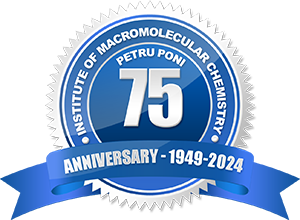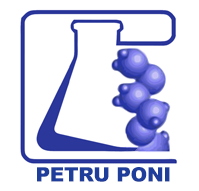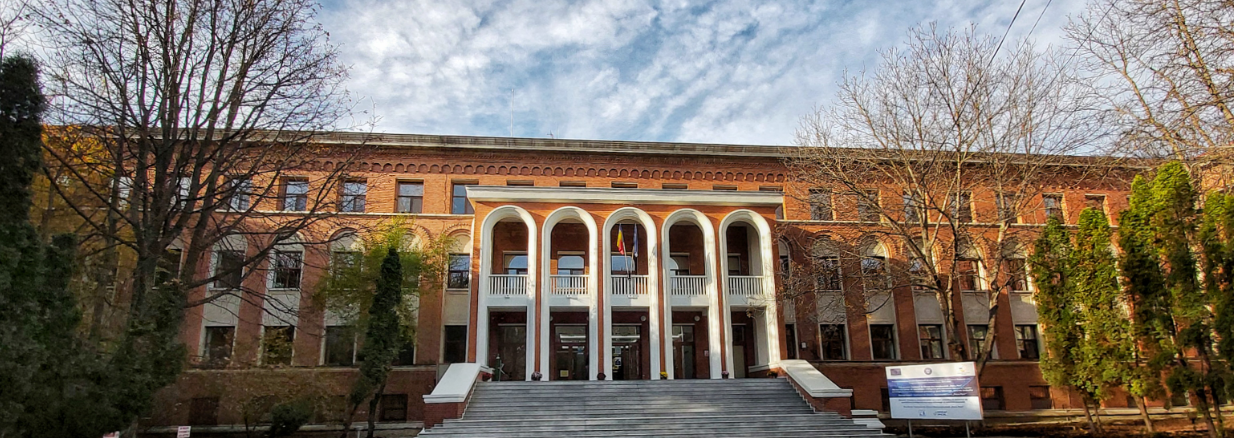Stage 1 (Objectives I & II, 2022)
- we have synthesized ligands and chelates, mainly Schiff bases, that can reversibly bind metal ions;
- we have synthesized metal organic complexes from the afore mentioned ligands and chelates with the metallic ions: Cu(II), Co(II), Ni(II) & Cd(II);
- we have synthesized snowman-type Janus nanoparticles (JNPs) consisting of two lobes, one coming from seed polystyrene nanoparticles PS-NPs and the other from a phase separated polymer poly(3-trimethoxysilyl)propylmethacrylate (PTSPM);
- we obtained homologous series of JNPs with varying amphiphilicity by adjusting the relative Janus lobe sizes;
- polidentated ligands, such as branched-polyethileneimine (b-PEI), were attached onto teh PTSPM Janus lobe of the JNPs (JNP-b-PEI) and we have shown that these are amphiphilic by showing their ability to lower the interfacial tension and stabilize Pickering emulsions;
- JNP-b-PEI have been utilized in the emulsification of molten wax and by cooling we obtained microspheres that are capable of binding transitional metal ions from water;
- we have syntehsized pseudoamphiphilic silica nanoparticles functionalized with certain functional groups (NP) that can also stabilize Pickering emulsions;
- wtih the silica NPs we were able to stabilize Pickering emulsions and obtain microspheres that were ion imprinted with the help of the ligand and metal-organic complexes;
- we have published one article showing that microspheres obtained from Pickering emulsions can extract ions from water.
Stage 2 (Objectives III, IV & V, 2023)
- we have synthesized several series of polymer microspheres carrying ligands utilizing the PEmPTech;
- these microspheres are capable of adsorbing metal ions from waters, and these were tested for Cu(II), Co(II), Ni(II) adsorbtion from model water samples;
- the adsorption and recovery capacity of the microsphere adsorbents is comparable with the capacity of ion imprinted material adsorbents reported in literature;
- we have also synthesized adsorbents as monoliths, blocks and composites that are capable of metal ion extractions from water;
- we have also obtained these adsorbents as films/membranes that are currently being tested for their adsorbtion capacites.
Stage 3 (Objectives VI & VII, 2024)
- we have tested the performance of the polymer adsorbents for their ability to extract ions from real water samples;
- the real water samples were collected from the Black Sea and Bistrita river;
- the performance for real water samples was excellent, with no loss in the adsorbtion capacities;
- the best performing materials were also tested for their capacity to adsorb a series of divalent ions, such as Cu(II), Ni(II), Co(II), Pb(II), Hg(II) and manifested selectivity and high adsorbtion capacities for Cu(II) and Pb(II);
- the best performing series of adsorbents in terms of adsorbtion capacity was further optimize by adjusting the following parameters: chemical composition, porosity, size of the particles, crosslinking degree and wettability;
- we have learned the effect of each of these parameters on the adsorbtion capacity of the polymer materials and established causal relationship whose control can lead to highly efficient adsorbent materials.
Conclusions: all the objectives of the projects have been succesfully completed.
Publications:
(1) Extraction of Metal Ions by Interfacially Active Janus Nanoparticles Supported by Wax Colloidosomes Obtained from Pickering Emulsions; O. Pauli, A. Honciuc, , Nanomaterials 12 (2022) 3738, doi.org/10.3390/nano12213738.
(2) Pickering Emulsion Polymerization Technology─Toward Nanostructured Materials for Applications in Metal Ion Extractions from Wastewaters; Honciuc, A.; Solonaru, A.-M.; Honciuc, M.; ACS Appl. Polym. Mater. 2023, 5, 8012–8022, doi:10.1021/acsapm.3c01267.
(3) Water-Floating Hydrogel Polymer Microsphere Composites for Application in Hydrological Mining of Cu(II) Ions; Honciuc, A.; Solonaru, A.-M.; Honciuc, M.; Nanomaterials 2023, 13, doi:10.3390/nano13192619.
(4) Reversible Cu-Nanoparticle Formation in Soft Hydrogel Composites: Towards Write-Erase Displays and Fluorescence Detection; A. Honciuc, M. Honciuc, A.-M. Solonaru, , Journal of Colloid and Interface Science 668 (2024) 37–49. https://doi.org/10.1016/j.jcis.2024.04.147.
(5) Interfacing Langmuir–Blodgett and Pickering Emulsions for the Synthesis of 2D Nanostructured Films: Applications in Copper Ion Adsorption, Nanomaterials; A. Honciuc, O.-I. Negru, M. Honciuc, 14 (2024) 809. https://doi.org/10.3390/nano14090809.
(6) Polymer Microspheres Carrying Schiff-Base Ligands for Metal Ion Adsorption Obtained via Pickering Emulsion Polymerization; A. Honciuc, O.-I. Negru, M. Honciuc, A.-M. Solonaru, J. Compos. Sci. 8 (2024) 271. https://doi.org/10.3390/jcs8070271.
(7) M. Honciuc, A. Honciuc, Morphological Design and Synthesis of Nanoparticles, Nanomaterials 14 (2024) 360. https://doi.org/10.3390/nano14040360.
Conferences (International):
(1) Fluid or Solid Ligand-Carrying Surface Nanostructured Microspheres Utilized in Extraction and Recognition of Metal Ions; A. Honciuc, A. M. Solonaru, O.I. Negru, M. Honciuc; 20th International Conference on Nanosciences and Nanotechnologies (NN23), Thessaloniki, Greece, 4-7 July 2023 (comunicare)
(2) Pickering Emulsion Polymerization Technology (PEmPTech) Applied for Ion Imprinted Polymers; M. Honciuc, A.M. Solonaru, O.I. Negru, A. Honciuc; 20th International Conference on Nanosciences and Nanotechnologies (NN23), Thessaloniki, Greece, 4-7 July 2023 (poster)
(3) Utilization of Polymerized Pickering Emulsions in Extraction and Recovery of Metal Ions from Waters; A. Honciuc, M. Honciuc, A.-M. Solonaru, O.-I. Negru, M. Medrihan, M. Asandulesa; 25th International Conference: Materials, Methods and Technologies, Burgas, Bulgaria, 17-20 August 2023 (comunicare)
(4) Wastewater Treatment with Innovative Material Produced by Pickering Emulsion Polymerization Technology (PEmPTech); A. Honciuc, M. Honciuc, A.-M. Solonaru, O.-I. Negru, M. Medrihan, M. Asandulesa 32nd International Conference: Ecology and Safety, Burgas, Bulgaria, 14-17 August 2023 (comunicare)
(5) Mitigating Pollution of Waters with Innovative Nanomaterials; M. Honciuc, A.-M. Solonaru, O.-I. Negru, A. Honciuc, M. Medrihan, M. Asandulesa 32nd International Conference: Ecology and Safety, Burgas, Bulgaria, 14-17 August 2023 (poster)
(6) Application of Functionalized Nanoparticles in the Synthesis of Ion-Imrpinted Polymers; M. Honciuc, A.-M. Solonaru, O.-I. Negru, A. Honciuc, M. Medrihan, M. Asandulesa; 25th International Conference: Materials, Methods and Technologies, Burgas, Bulgaria, 17-20 August 2023 (poster)
(7) Advanced 2D Nanostructured Films Engineered via Langmuir-Blodgett and Pickering Emulsions for Cu(II) Ion Removal in Wastewater Treatment A. Honciuc, O.-I. Negru, M. Honciuc, 33d International Conference: Ecology and Safety, Burgas, Bulgaria, 12-15 August 2024 (comunicare)
(8) Dynamic Cu-Nanoparticle Formation in Soft Hydrogel Composites for Reversible Write-Erase Displays and Fluorescence Detection, A. Honciuc, M. Honciuc, A.-M. Solonaru, 26th International Conference: Materials, Methods and Technologies, Burgas, Bulgaria, 15-18 August 2024 (comunicare)
Conferences (National):
(1) Pickering Emulsion Polymerization Technology (PEmPTech) Utilized for Obtaining Ion-Imprinted Polymer Materials; M. Medrihan, A. Honciuc, V. Harabagiu, A.-M. Solonaru, O.-I. Negru, M. Honciuc, 5th Ed. IasiCHEM, Iasi, Romania, 26-27 Octombrie 2023 (comunicare)
(2) Synthesis of Ion Imprinted Polymer Microspheres by Pickering Emulsion Polymerization Technology; O.-I. Negru, A. Honciuc, M. Honciuc, A.-M. Solonaru, M. Medrihan; 5th Ed. IasiCHEM, Iasi, Romania, 26-27 Octombrie 2023 (comunicare)
(3) Synthesis of Polymer Microparticles and their Application in the Extraction of Heavy Metal Ions from Aqueous Environments; A.-M. Solonaru, A. Honciuc, M. Honciuc, O.-I. Negru, M. Medrihan; 5th Ed. IasiCHEM, Iasi, Romania, 26-27 Octombrie 2023 (poster)
(4) Nanostructured polymer materials obtained from Pickering emulsion polymerization technology; M. Medrihan, A. Honciuc, V. Harabagiu, O.-I. Negru, A.-M. Solonaru, M. Honciuc; the 4th Edition of Open Door to The Future. Scientific Communications of Young Researchers, MacroYouth’2023, 17th of November 2023 (comunicare, premiul al III-lea pentru cea mai buna prezentare)
(5) Fundamentals and applications of amphiphilic Janus nanoparticles, A. Honciuc, XXXVII Edition of the National Conference on Chemistry, "CNCHIM 2024"”, , Târgoviste, România, 25-27 Septembrie 2024 (conferință)
(6) Polyphenols encapsulated in polymeric microparticles: absorption and release properties, M. Honciuc, A. Honciuc, A.-M. Solonaru, XXXVII Edition of the National Conference on Chemistry, "CNCHIM 2024"”, , Târgoviste, România, 25-27 Septembrie 2024 (comunicare)
(7) Microspheres obtained from pickering emulsion stabilized by Janus nanoparticles as adsorbents of metal ions from water, A.-M. Solonaru, A. Honciuc, M. Honciuc, O.-I. Negru, XXXVII Edition of the National Conference on Chemistry, "CNCHIM 2024"”, , Târgoviste, România, 25-27 Septembrie 2024 (comunicare)
(8) Polymeric microspheres obtained from Pickering Emulsion Polymerization Technology (PEmPTech) for colorimetric recognition of metal ions, M. Medrihan, A. Honciuc, V. Harabagiu, M. Honciuc, A.-M. Solonaru, O.-I. Negru, XXXVII Edition of the National Conference on Chemistry, "CNCHIM 2024"”, , Târgoviste, România, 25-27 Septembrie 2024 (comunicare)
(9) Obtaining polymer microspheres through Pickering Emulsion Polymerization Technology, 6th Ed. IasiCHEM, Iasi, Romania, 31st Octombrie – 1st Noiembrie, 2024 (comunicare).
|








